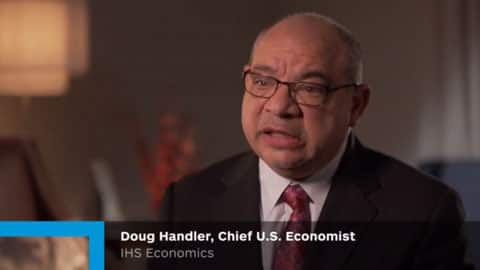Video: US economic outlook
Through 2016, the US will be among the fastest-growing developed countries. Growth levels will be determined by productivity, use of machinery and hours worked.
Interview Transcript
The outlook to 2016
The economic outlook for US through 2016 is either a glass half empty or a glass half full type of view here, depending on your perspective. From a global perspective, actually, things look quite good in the US. The US will be one of the fastest growing major developed countries in the world. We're looking for growth of 2.2 percent real GDP in 2014 rising to 2.6 in 2015 and 2.8 in 2016. By global standards this is fantastic. However, by US standards this is just so-so. Growth in the 10 years preceding the recession averaged around 3.2 percent, so we're subpar even with this acceleration in growth. Moreover, there's an output gap here, meaning there's excess capacity in the US economy that really should be utilized much more effectively then it is, meaning growth should be much faster then it is as well. So we're growing well, but not as good as we should be. If we look by sector, the big areas will be consumer spending and business investments spending - both domestic components. And there'll be a small off set in the international growth areas as well, driven by the rising dollar and little bit weaker growth outside the US.
What signposts should be watched?
There are certain signposts that we should be watching for to determine if our economic growth forecast is going to come true in the coming years here. If we look at real GDP growth, there are only three things that'll drive it. One is an increase in the number of hours worked. Two is an increase in the machinery that's used to produce our output. And three is productivity, which can be considered the better combinations of the labor and capital here, and innovation would be included in that third category as well. So let's look at these really briefly. So with respect to the number of hours worked, we're going to have challenges with the labor force supply into the future; we're getting older. Labor force participation rates are declining. We really can't count on the labor force supply for that much growth. We look at capital, we do see capital investment as being better in the next couple of years than in the past couple years, but really not that much of an improvement is expected here. So pretty much capital will be doing its fair-share of the growth, but that sector won't really be contributing much more than that. So if the economy is going to kick-start from just so-so growth to really fast growth, it's going to be in the productivity statistics. We'll be needing to look at the output per hour and tracking the progress on that; of course output per hour is a function of all the tools and the wherewithal to produce more things more effectively - that would be education, that would be infrastructure, technology, innovation - all of those are going to be the…are going to drive the measurements that we're going to need to see better growth.
Doug Handler, Chief US Economist, IHS Economics
